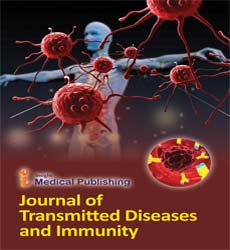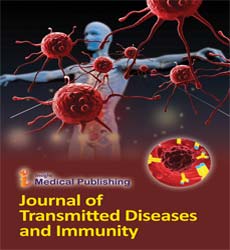ISSN : 2573-0320
Journal of Transmitted Diseases and Immunity
A short note about the immune system and its types
Esan Jacob*
Principal Medical Laboratory Scientist, Hematology Department, Federal Teaching Hospital, Ido-Ekiti, Nigeria
- *Corresponding Author:
- Esan Jacob
Principal Medical Laboratory Scientist, Hematology Department, Federal Teaching Hospital, Ido-Ekiti, Nigeria
E-mail: esanjacob@gmail.com
Received Date: November 18, 2021; Accepted Date: November 25, 2021; Published Date: December 02, 2021
Citation: Jacob E (2021) A Short Note about the Immune System and its Types. J Transm Dis Immun. Vol.5 No.6:51.
Editorial
The safe framework alludes to an assortment of cells, synthetic compounds and cycles that capacity to secure the skin, respiratory entries, digestive system and different regions from unfamiliar antigens, for example, microorganisms (living beings like microscopic organisms, growths, and parasites), infections, disease cells, and poisons. Past, the primary and compound hindrances which shield us from contamination, the insusceptible framework can be straightforwardly seen as having two "lines of guard": intrinsic invulnerability and versatile insusceptibility. Natural resistance addresses the main line of guard to an encroaching microorganism. It is an antigen-autonomous (vague) safeguard system that is utilized by the host promptly or not long after experiencing an antigen. The intrinsic invulnerable reaction has no immunologic memory and, hence, it can't perceive or "remember" a similar microorganism should the body be presented to it later on. Versatile insusceptibility, then again, is antigen-ward and antigen-explicit and, thusly, includes a slack time between openness to the antigen and maximal reaction. The sign of versatile insusceptibility is the limit with respect to memory which empowers the host to mount a more quick and productive invulnerable reaction upon resulting openness to the antigen. Intrinsic and versatile resistances are not totally unrelated instruments of host protection, yet rather are reciprocal, with surrenders in either framework bringing about have weakness or improper reactions.
Innate immunity
The Innate immunity framework is made of guards against disease that can be initiated promptly once a microorganism assaults. The inborn resistant framework is basically comprised of boundaries that mean to keep infections, microorganisms, parasites, and other unfamiliar particles out of your body or breaking point their capacity to spread and move all through the body. The natural insusceptible framework incorporates:
•Physical Barriers: such as skin, the gastrointestinal plot, the respiratory parcel, the nasopharynx, cilia, eyelashes and other body hair.
• Defense Mechanisms: such as emissions, mucous, bile, gastric corrosive, spit, tears, and sweat.
•General Immune Responses: such as irritation, supplement, and vague cell reactions. The fiery reaction effectively brings insusceptible cells to the site of a contamination by expanding blood stream to the space. Supplement is a resistant reaction that marks microbes for obliteration and makes openings in the cell film of the microorganism. Look at our video that clarifies irritation and supplement, which we will address later.
The natural insusceptible framework is consistently broad, or vague, which means whatever is recognized as unfamiliar or nonself is an objective for the inborn resistant reaction. The inborn safe framework is initiated by the presence of antigens and their synthetic properties.
Adaptive immunity
Adaptive immunity is an invulnerability that happens after openness to an antigen either from a microbe or an inoculation. This piece of the invulnerable framework is initiated when the inborn safe reaction is inadequate to control a contamination. Indeed, without data from the intrinsic resistant framework, the versatile reaction couldn't be assembled. There are two sorts of versatile reactions: the cell-intervened resistant reaction, which is done by T cells, and the humoral safe reaction, which is constrained by actuated B cells and antibodies. Initiated T cells and B cells that are explicit to sub-atomic designs on the microorganism multiply and assault the attacking microbe. Their assault can kill microorganisms straightforwardly or emit antibodies that improve the phagocytosis of microbes and upset the disease. Versatile invulnerability additionally includes a memory to furnish the host with long haul assurance from reinfection with a similar sort of microbe; on re-openness, this memory will work with a proficient and fast reaction.

Open Access Journals
- Aquaculture & Veterinary Science
- Chemistry & Chemical Sciences
- Clinical Sciences
- Engineering
- General Science
- Genetics & Molecular Biology
- Health Care & Nursing
- Immunology & Microbiology
- Materials Science
- Mathematics & Physics
- Medical Sciences
- Neurology & Psychiatry
- Oncology & Cancer Science
- Pharmaceutical Sciences
